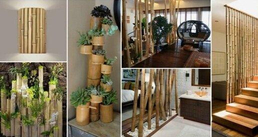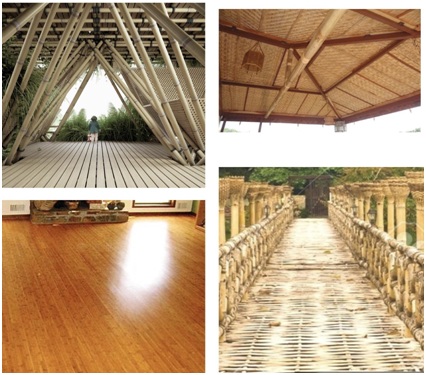Cane & Bamboo Industry of India

CANE & BAMBOO INDUSTRY OF INDIA
India has long been a hub for traditional bamboo and cane products. Since ancient times, bamboo and cane were used by the tribal as a means for expressing their creativity and artistic streak as well as to make useful items of daily use. Indian handicrafts, especially products made from cane and bamboo are manufactured at low costs in several states of India, especially those which are naturally blessed with these natural resources. Bamboo craft-making forms an essential part of the northeast Indian economy. The intricately designed bamboo crafts highlight the rich tradition of the region and over the years has received global appreciation. The furniture created by cane and bamboo features lucidness and comfort due to aesthetic beauty and appeal. It covers the wide expanded land rich in natural resources such as Assam, Sikkim, Nagaland, Arunachal Pradesh etc.
The history of this handicraft can be traced to the 2nd century AD. The classical literature has talked about the huge bamboo and cane forest. Ptolemy talks about the hilly and marshes of cane crown and used as bridges in Assam. In Hashacharitra Bana also gave evidence about the highly developed craft sent by King of Assam Bhaskara Varma to Emperor Harsha, the goodies were baskets of variously colored reeds, thick bamboo tubes, and birds in the Bamboo cages.
The cane products though are mostly available in natural color give a very trendy look and are recognized for its durability, low weight, easy maintenance, and eco-friendliness. Cane is noted for its special property despite being quite strong it can also be bendable easily and thus making it ideal for furniture making.
In today's scenario cane is seen used in making all types of furniture like chairs, tables, sofas, stools, shoe racks, bookshelves, cabinets, beds, couches, recliners, etc. The cane products in India are available at different price ranges suiting the budget of all classes of people.
In 2002 India Post issued a series of four stamps in a miniature sheet. These stamps depicted different handicrafts, one of them the Cane and Bamboo work. The stamp features a flower pot and jar made of cane and bamboo.
Before going into the depth of cane and bamboo products, first we should know what bamboo and cane are.
Bamboo is a very tall, fast growing perennial grass. The different parts of the bamboo are used for different purposes. For example, the shoot of the bamboo is used in cooking while the fibres are used to create textile. Various qualities like suppleness, durability, abundance, tone, and resiliency and of course the quick maturity of bamboo have made it a very popular choice for making cane furniture. Some of the most common and highly economically valued bamboos include the Muli (Melocannabambusoides), Dalu (Drepanostachyumdallas), Khang (Dendrocalamuslongispathus), Kaligoda (Oxytenantheranigrociliata) and Pecha (Dendrocalamus Hamilton-ii). The Muli and the Dalu have great commercial importance, the former for pulping, constructional and fencing purposes, and the latter for the mat and basket industry. The growth rate of bamboo is quite fast and can be harvested continuously for many years
Cane refers to the hollow stem of a tall grass.
It is observed that generally three species of cane are exploited in commercial quantities- Jati (Calamus tenuis), Tita (Calamus leptesadix) and Lejai (Calamus floribundus). Some less important qualities like Sundi (Calamus garuba) and Raidang (Calamus flagellum) are also extracted. When compared to oak, cane is much stronger and is not affected by water and gives an aesthetic look which is proved to be a sustainable natural resource and a pioneer material in the movement for eco-friendly furniture.
Caning is the process or craft of weaving furniture and other cane related products. The material used in this art is cane and the process is known as caning and the outcome is the cane product. Cane products which are more eco- friendly are no longer an outdoor decor or show a rusty living but are made more trendy for contemporary living. Even the unrefined natural bamboo furniture, milled and laminated bamboo with a darker stained finish is leading the way as the new look of eco- furniture.
POPULAR INDIAN STATES FOR ITS CANE & BAMBOO WORK:

- Assam- The state of Assam is a treasure trove of cane & bamboo natural resources, thanks to its abundant cane and bamboo forests. As many as 51 species of bamboo grow in Assam and they are being used for diverse purposes, mainly for buildings, furniture, and diverse contraptions. The cane craft in Assam is practiced by a wide range of the peasant group irrespective of caste and community. Assam has over the years, seen considerable socio-economic growth and sustained development due to its dedicated, skilled artisans and its beautiful natural resources. Bamboo and cane craft of Assam is specifically a household craft industry in the state and offers farmers with a part-time employment option. It is practiced as a household industry and no mechanical device is used. Various products such as bamboo houses, bamboo baskets, bamboo mats, bamboo hats, handicrafts like toys and dolls, musical instruments etc. are crafted here out of the bamboo or cane. The bamboo houses are a combination of bamboo matting and wooden framework. Folk medicines made from bamboo are used in rural areas of Assam for fresh cuts, body ache, toothache, dandruff etc.
- Manipur- Manipur in the North East of India is the second largest producer of bamboo and bamboo products, the first being Tripura. It is popular for its traditional cane and bamboo craft. Some of the districts like Jiribam, Imphal and Tamenglong are especially well known for their abundant bamboo resources. Some of the most popular bamboo and cane items from Manipur include a range of items, meant for decoration and daily use. Ashtrays, Umbrellas, Ornaments, Sofa Sets, Fishing Baskets, Storage Baskets, Mats, and sofa sets, etc., are immensely popular. Bamboo and cane crafts remain an integral part of Manipur's economy, lifestyle. it has now been a thriving business in Manipur. It also acts as a catalyst in generating employment in the state.
- Tripura- The bamboo/cane crafts of Tripura show remarkably extensive weaving patterns, unique styles, and attractive designs. Simple tools are used to split the bamboo and cane vertically and impart their surface with a striking evenness. The artisans of Tripura craft various attractive items out of bamboo and cane and it includes things like Dulla or fish basket, Pathee or rain shield, kula, dala, trays, pencil holders, lamp shades, table mats, decorative fans, door screens, stools, vegetable baskets, shopping bags and many more.
- Kerala- The state of Kerala is a popular tourist destination. It has a rich tradition of manufacturing beautifully painted mats and checkered black and white square boxes made of bamboo. While these items serve as excellent gifts, they also energize the handicraft market of this region. Some of the most popular bamboo and cane items from Kerala are Bamboo Boxes, Mats, etc.
- Arunachal Pradesh- The state of Arunachal Pradesh has a rich tradition of bamboo and cane crafts. The bamboo craft of Arunachal Pradesh is highly diverse with the designs, styles and patterns varying from one tribe to another. Some of the most popular bamboo and cane items from Arunachal Pradesh include – Cane Belts, Baskets, Mats, Ornaments, Head Gear, Houses, Bridges, Smoking pipes, Trays, Knives, Barrels, and storage pouches.
- Meghalaya- Bamboo/cane trees abound in Meghalaya and the trees grow super-fast and are available in multiple varieties. Khoks/artistic baskets, bamboo houses, mats, stools, Kurup or special type of Khasi umbrella are some of the major bamboo/cane products produced in Meghalaya. Meghalayan bamboo crafts is a crucial part of the daily lifestyle of Meghalaya
- Mizoram- Mizoram has an abundant supply of the raw materials for bamboo crafts. Bamboo baskets are an important product that the artisans of Mizoram commonly craft out of Bamboo. These baskets come in various sizes, shapes and serve various purposes. Broad baskets, for instance, are used for storing vegetables, cotton, and firewood. Baskets with a lid are used for storing grains. The various other products made from bamboo/cane in Mizoram include pipes, toys, hats, umbrella handles, fish baskets, mugs, weaving tools and even houses.
- West Bengal- The state of West Bengal is another state of India, well known for its Bamboo and Cane products. Thousands of artisans in West Bengal are involved in the production of bamboo and cane mats as well as eye catching and elegant screens & panels. Some of the most popular bamboo and cane items from West Bengal include – Panels, Screens, Mats etc
- Tamil Nadu- Within Tamil Nadu, Chennai, Thanjavur districts are popular for their Cane products. Some of the most popular bamboo and cane items from Tamil Nadu include – Baskets, Bowls, Trays, Furniture and Kora Grass Mats, etc.
- Nagaland- The state of Nagaland produces a huge amount of bamboo and cane and artisans therein make good use of these available resources to craft out amazing artifacts. It is often remarked in a hyperbolic manner that life in Nagaland begins on a bamboo cot and ends in the bamboo coffin. Bamboo crafting makes an integral part of Naga culture and their forte lies in making beautiful furniture pieces out of bamboo. So, these artisans would make awesome tables, chairs, sofas and cots out of bamboo/cane. Cane baskets too are very common in Nagaland and every woman takes pride in flaunting one as accessory
- Sikkim- Bamboo/cane crafts are a flourishing craft in Sikkim and every lane of Sikkim has workshops of bamboo/cane crafts where marvelous bamboo/cane crafts are produced by the artisans. Bamboo showpieces, mats, baskets, furniture are some of the common products made by the artisans of Sikkim.

- Uttar Pradesh- Allahabad, Kanpur and Bareilly are popular places known for Cane and Bamboo work. Cane and Bamboo are the most commonly used materials to make furniture and household items which are essential for daily life. Artisans deliver high quality work through their products. Furniture frame is made with thick bamboo by heating, bending and joining. Finally, the frame is rounded with a thin processed cane called 'Gola'. The tradition of cane and bamboo work started nearly 40 to 50 years back and carried from older generations to younger generations. The motif patterns are created with their own imaginative idea and skill without using any traced design. The final products are produced to cater to the local need.
PROCESS OF MAKING THE CANE PRODUCTS:
The manufacture of cane and bamboo products are mostly carried on outdoors and the craft does not require any housing arrangement particularly in rural areas. In the urban areas, however, it is found that cane products are manufactured in workshops and most of the establishments are housed in rented buildings.
The initial process in the making of any cane related products is to check for flaws. The stalks of bamboo are cut into thin sections. To increase the moisture content the cut bamboo strips are boiled at a temperature of 1000°C for 24 hours approximately. Copper sulphate solution is added in order to defend against fungal and insect attacks. Once the desired color is achieved the bamboo is dried in fresh air or in a kiln. The moment we talk about bamboo its natural light color comes into picture. But however, the steaming process imparts a dark colour to the bamboo which still does not affect the durability. The color can be adjusted according to requirement by adjusting the temperature where higher the temperature the deeper the colour. The Food and Agriculture Organization of the United Nations recommends steaming at a pressure of 3-5 kg/sq. cm. for 90-105 minutes in order to produce a chestnut shade. This carbonized bamboo is the new trend hitting the eco-furniture market.
The ductile flexible bamboo is stripped smooth after the steaming process. After the bamboo is smoothened it is laminated and then screwed together or glued together. The piling process is usually done with roller spreaders, spray lines, curtain coaters or brushes to form vertical grain bamboo panels. Once the panels are ready, they are assembled to arrive at various products like chairs, tables, sofas, bookshelves, and cabinets. Different methods are followed to assemble the bamboo furniture and the most common one is to entwine the vertical grain bamboo panels with a pre-molded frame of bamboo or wood. Many bamboo furniture makers fasten strips of bamboo around important joints to reinforce them. Rope and hemp is also used in the process of fastening. Once everything is done a coat of lacquer is applied to the product and also some furniture companies treat the products against parasites.
The essential tools required for bamboo craft consists of a ‘dao’ (billhook), a knife and a ‘jak’ (‘v’ shaped wooden frame). In manufacturing cane products also, ‘daos’ and knives are mainly used, and only the furniture making establishments use a few saws, hammers, pliers and pincers in addition to daos and knives. A few more hand tools are found to be employed in the manufacture of bamboo umbrella handles. The tools and implements used in the craft are ‘bakaikol’ (bending frame), ‘narum’ (sharp and pointed carving blade), files, saws, knives, blowpipes, tongs, oven, etc.
SCOPE & CHALLENGES:
Over the years, bamboo and cane products have continued to be in great demand, especially Cane Furniture. What is fascinating to note is that this traditional, age-old art continues to be popular even today, thanks to the sustained efforts of development centres, Government initiatives, and non-profit organizations.
The concept of cottage industries in India has transformed the lives of unemployed, uneducated, local artisans who are gifted in several traditional art forms of India. Besides providing a dependable source of livelihood to the locals, these industries have managed to promote some of India’s oldest art forms.
The main raw materials for the industry, i.e. bamboo and cane of various types are abundantly available. It requires little or no investment and can be pursued by anybody and everybody of a household as a subsidiary occupation. As such, the industry has considerable scope for development and various new products suited to modern tastes can be manufactured out of bamboo and cane.
However with modernization there are a lot of urbanized establishments which are involved in the manufacturing of various types of cane furniture and other sundry articles, like boxes, murrahs, cradles, office trays, bottle carriers, tiffin baskets, bicycle baskets, waste paper baskets, etc. Because the above-mentioned products require a lot of man power the cost of the products are also higher than the regular bamboo products. Therefore, Market intelligence is required to be developed so that products can be made to cater to the need of the consumer market as well as it helps in the betterment of the livelihood of artisans.
FINEST RAW MATERIAL FOR ECO-FRIENDLY PRODUCTS:
There is no issue more pressing as climate change all over the world today. It is being discussed in-depth at apex global forums and countries all over.
Towards this cause, bamboo has been identified as strategic resources for countries to address the adverse effects of climate change. Bamboo also has all the potential to contribute towards achieving sustainable development goals, especially for countries like India, being the second-highest bamboo growing country in the world.
Bamboo is a wonderful, natural, and renewable resource. It is capable of rapid growth which can avoid future deforestation. The mere fact that they are very easy to grow, bamboo is seen as one of the finest materials that we can use in creating an eco-friendly and sustainable product that won’t cause serious harm to our environment unlike those that are made of plastic materials.
Bamboo is 100% biodegradable and can be easily regenerated which is the reason why almost all companies whose mission is to offer eco-friendly products use bamboo as one of their raw materials. Bamboo products are eco-friendly if they haven’t been chemically processed, meaning no harmful chemicals were added.
Since bamboo is 100% natural, it goes back to nature through the process of decomposition quickly. Bamboo has a lot of amazing benefits as compared to plastic, rubber or other man-made materials used in production.
So far as protection of the planet is concerned, bamboo has the potential to provide us with the much-needed solutions. Bamboo releases 35% more oxygen than other plants to the environment and bamboo sequester 20% carbon dioxide from the environment. Scientific plantation of bamboo could dramatically improve air quality with the release of more oxygen and sequestering more carbon dioxide.
India can certainly boast that Numaligarh Refinery Ltd. is setting up a bio-fuel refinery in Assam which will produce ethanol from bamboo. The Assam government seems to have woken up to the call and revamped its state bamboo mission recently. The Tripura Government has certainly been doing good work on the bamboo sector consistently for several years.
Bamboo is fast proving to be a superior alternative to wood and plastic for many uses. Bamboo is an ideal construction material that has been gaining traction. Bamboo flooring has been well accepted in the global market. Bamboo fabric apparels and clothing are fast gaining popularity, especially due to its intrinsic characteristics such as naturally organic, anti-fungal, antibacterial, ultra-soft, super-absorbent and thermostatic. Bamboo cosmetic brands have entered the premium segments of markets in various countries. Bamboo beverage brands are being launched in various parts of the world. Bamboo has also occupied a place in Lexus car’s dashboard and steering wheels. Many car manufacturers are considering bamboo as an ideal alternative for car interiors.

 1,12,000 Artisans families benefited so far
1,12,000 Artisans families benefited so far
